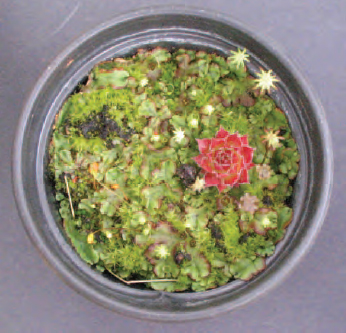 |
Figure 13.16 Pot plant compost covered with moss
and liverwort |
These simple plants may become weeds in wet growing conditions.
The small cushion-forming moss (
Bryum spp.) grows on sand capillary
benches and thin, acid turf that has been closely mown. Feathery moss (
Hypnum spp.) is common on less closely mown,
unscarified turf. A third type (
Polytrichum spp.),
erect and with a rosette of leaves, is found in dry
acid conditions around golf greens. Liverworts
(
Pellia spp.) are recognized by their flat (thallus)
leaves growing on the surface of pot plant compost
(see Figure 13.16).
These organisms increase only when the soil
and compost surface is excessively wet, or when
nutrients are so low as to limit plant growth. Cultural
methods such as improved drainage, aeration,
liming, application of fertilizer and removal of shade
usually achieve good results in turf. Control with
contact scorching chemicals, e.g. alkaline ferrous
sulphate, may give temporary results. Moss on sand
benches becomes less of a problem if the sand is
regularly washed.





